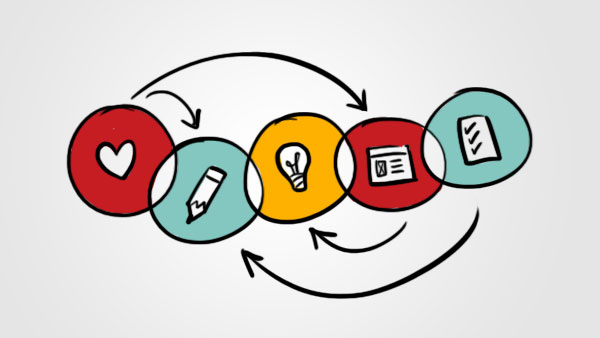Ikea. Apple. GE. Fidelity. Nike. Aside from being globally recognized household names, can you guess what these companies (and many more) have in common?
They’ve all made huge strides in their business by embracing design thinking as part of their marketing strategies.
Design Thinking, Defined
As a concept, design thinking is disruptive but definitely not new- it originated back in the 1950s, when famed inventor Buckminster Fuller convened groups of experts in a variety of fields to solve systemic failures. His teams were curated from the world’s best universities- not just designers, but engineers, scientists, and inventors- and he created a repeatable iterative methodology whereby they could identify and address problems.
Essentially, Fuller spearheaded a multidisciplinary approach to problem-solving. The collaboration of these brilliant minds resulted in innovations like the geodesic dome and the Dymaxion car.
His wild approach is the genesis of today’s design thinking- put simply, it’s human-centered thinking, focusing less on the goal than on the ways to reach that goal.
By developing a deeper and broader understanding of who your customer is- truly endeavoring to get into their brain, or understand what motivates them- you can eventually gain a valuable level of insight into their needs, and the problems you can help them solve.
Because it’s innately intertwined with storytelling and emotion, marketing is an ideal climate for design thinking. And its iterative, cooperative approach lends itself well to scaling for companies big or small. It’s an agile approach to solving problems quickly, creatively, and uniquely.
Getting Started With Design Thinking
The first step is identifying a complex challenge you want to tackle with some collaboration and innovation. Maybe it’s an ongoing issue- or maybe it’s a struggle you’re seeing with your customer base that your company is distinctly capable of solving, given the chance.
Next, gather your team- and think outside the box. If you’d typically invite a web designer, a UX writer, and a marketing project manager, add someone from business development, technical support, and customer service. A diverse team with a mix of expertise will help you collectively find a broader perspective, and ultimately land on a solution that is more specifically designed for your audience.
Once you’ve identified your goal and the team you’re collaborating with to get to the goal, it’s time to execute.
Here you’ll want to keep the three tenets of Design Thinking front and center:
- Empathy
Go past simply understanding why your customers want to buy from you or your competitors. Figure out what drives them- why are they looking at your product or service in the first place?
Put yourself in their shoes.
What are they feeling, and why? By exploring emotion, rather than action, you can pinpoint what your customers need, and how to ensure they will trust you to meet those needs.
- Ideation
There is a term in design thinking- “flare before focus”– that captures this tenet nicely and is also a great forum for graphic facilitation or sketchnoting. Basically, you are attempting to gather as many flares of brilliance from customer stories or experiences before you focus on a fix for the problems.
This tenet is intentionally not called brainstorming.
Design thinking goes further than tossing ideas around and seeing what sticks- here’s where iteration is key.
You might be designing something to overcome an intangible or somewhat nebulous concept like trust (see the AirBNB story on this here).
Or you might decide to take something simple that’s become more engineered over time, and bring it back to its roots, based on your customers’ price point or pain point (like Dollar Shave Club).
The point here is twofold- say yes to ideas that are coming from different points of view, and don’t be afraid to take a risk if it aligns closely with what you’re feeling from your customer’s point of view.
- Experimentation
Beta release, soft launches, and usability testing are crucial components to design thinking success. Encourage feedback early, often, and continuously throughout the process- and if your idea is a failure, scrap it quickly so you don’t waste precious time or money.
The best ideas come from failing fast – it’s important not to get caught up in what doesn’t resonate, so you can move on to a great idea that does.
Design Thinking Benefits Beyond the Bottom Line
Ultimately, embracing design thinking can spark innovation, creativity, and even an increased sense of trust- not only between a company and its clients but between those at the company. Inviting people to contribute to solving problems and collaborate on unique approaches is great for team building- and for building long-lasting customer relationships. You may even find that design thinking seeps into other areas of your business (as in this case study from Discount Tire).
Interested in more inspiration? Check out this excellent curation of ideas that came about via design thinking.

